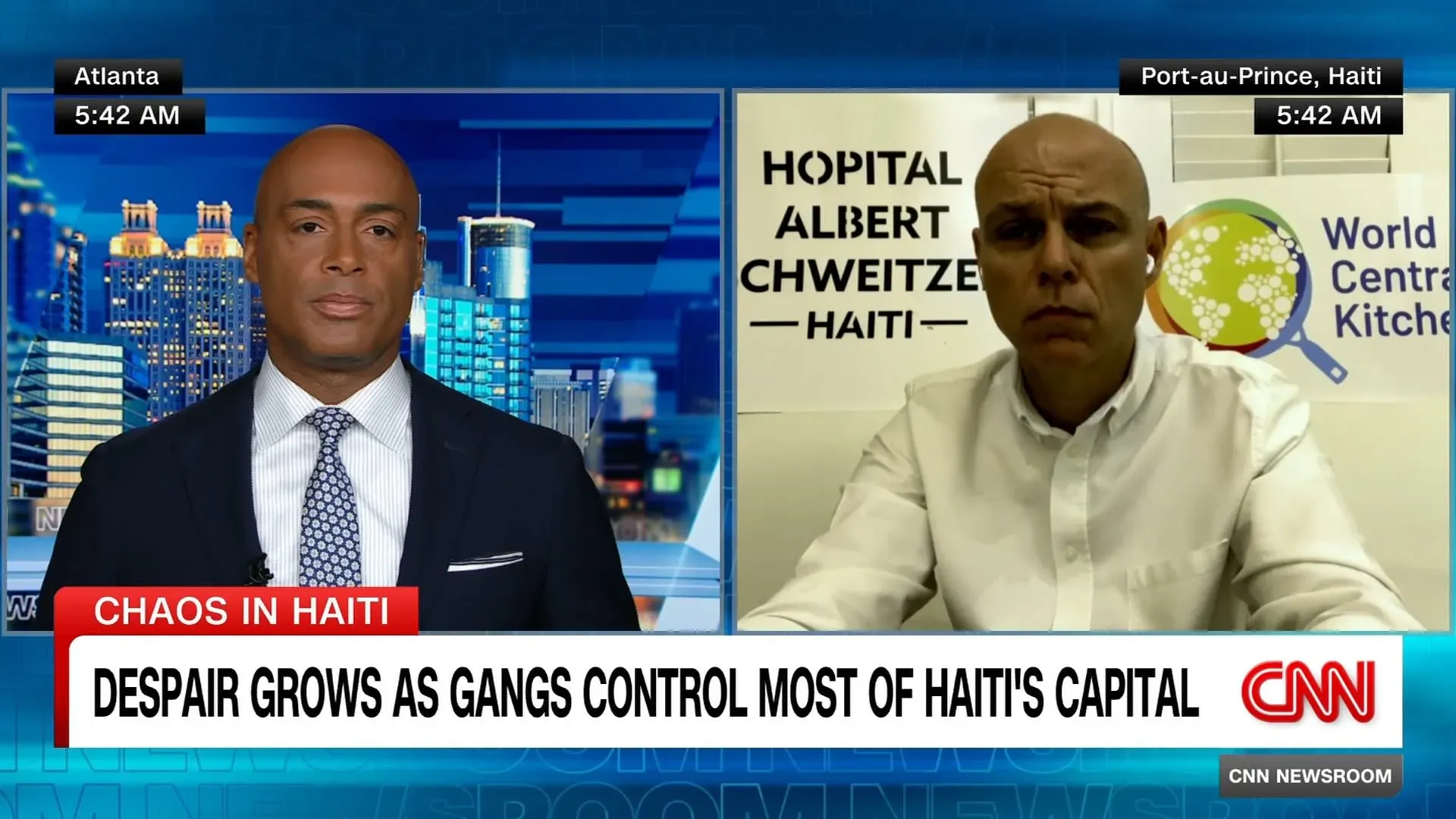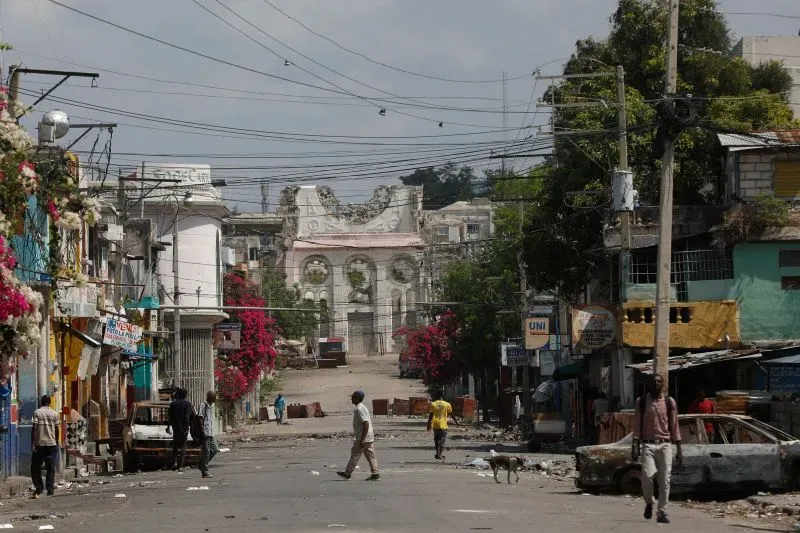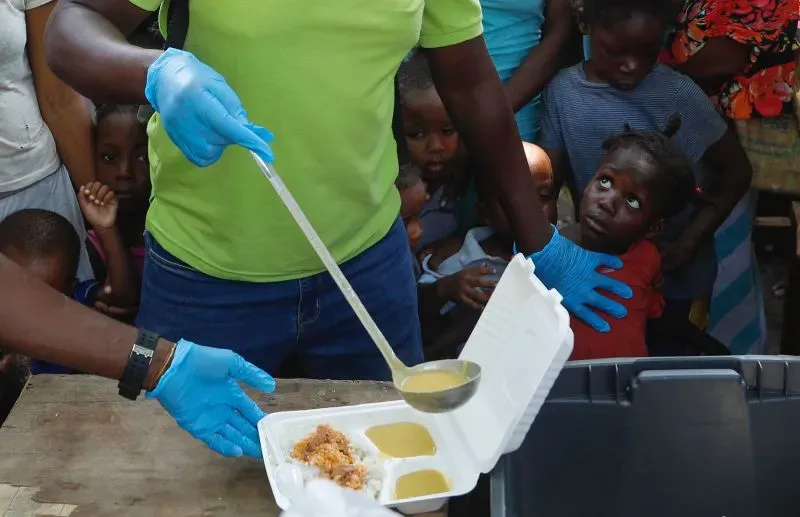أزمة الجوع في هايتي: تحذيرات من تفاقم الوضع
أخبار هايتي: البلاد تكافح مع وباء العصابات والانسداد السياسي، والأمم المتحدة تحذر من أزمة غذائية حادة. اقرأ المزيد على موقعنا.




تفشي الجوع في هايتي: الأسباب والتداعيات
يحذر العاملون في مجال المساعدات والأطباء والمبشرون المتطوعون بزيادة تصاعدية من أن شهية المواطنين في هايتي تنقص بشكل متزايد، حيث تكافح الأمة الكاريبية للخروج من الانسداد السياسي والوباء الذي يتسبب في عنف عصابات مميت.
ذكر أحد المبشرون الأمريكيين الذي تقدم منظمته الطعام والمياه للمحتاجين في المناطق التي تسيطر عليها العصابات في العاصمة بورت أو برنس لـ CNN أنه التقى بالفعل بأشخاص لم يتناولوا الطعام منذ أسبوع.
وفي بعض مناطق المدينة، لم يعد هناك طعام يمكن شراؤه، ولا يوجد أي طعام يمكن إحضاره إلى السوق لأولئك الذين يعتمدون على التجارة الصغيرة، وفقًا للمبشر الذي طلب عدم الكشف عن هويته حفاظًا على سلامته الشخصية. "تختفي العناصر واحدة تلو الأخرى. لا يوجد سلسلة توريد، لذلك عندما ينفد الدقيق والسكر والملح والأرز وما إلى ذلك، فإنها تنفد".
بعد إعلان رئيس الوزراء أرييل هنري عن استقالته الشهر الماضي، لم يشكل القادة السياسيون للبلاد حكومة جديدة بعد، وتوقفت مهمة أمنية متعددة الجنسيات متوقعة منذ فترة طويلة في ظل الارتباك. وفي الوقت نفسه، قامت العصابات بقطع بورت أو برنس عن بقية العالم، مما يجعل من "مستحيل تقريبًا" وصول المساعدات إلى ما لا يقل عن 58,000 طفل يعانون من أخطر مستويات سوء التغذية، وفقًا لليونيسف.
الوضع الإنساني في هايتي: الأرقام والحقائق
يمكن أن يشعر الأزمة في العاصمة في جميع أنحاء البلاد، التي تعتمد بشكل كبير على الواردات التي تمر من خلال بورت أو برنس. ووفقًا للأمم المتحدة، يعاني ما يقرب من 5 ملايين شخص في هايتي من عدم الأمان الغذائي الحاد - الذي يعرف عندما يشكل عدم قدرة الشخص على تناول الطعام الكافي خطرًا فوريًا على حياتهم أو معاشاتهم.
أزمة سوء التغذية: أزمة من صنع البشر
"هذه أسوأ أزمة إنسانية في هايتي منذ زلزال عام 2010. لا أعتقد أن هذا قد غرق في الواقع"، قال جان-مارتن باور، مدير برنامج الأغذية العالمي في هايتي، لـ CNN الأسبوع الماضي.
على مدى الشهرين الماضيين، تم انقطاع بورت أو برنس عن العالم، مع تناقص مواردها. تم إغلاق الطرق المؤدية إلى وخارج المدينة من قبل العصابات، وتم إغلاق المطار الدولي والميناء الدولي بشكل مماثل. تم تخريب المستشفيات، وتم كسر المستودعات والحاويات التي تخزن الطعام والمؤن الأساسية في جميع أنحاء المدينة في الأسابيع الأخيرة مع تفكك النسيج الاجتماعي.
في الشهر الماضي، تمت هجمات على محطة الحاويات الرئيسية - الحيوية لسلسلة الإمداد بالطعام في هايتي - وتم نهبها. وقد تم كسر حاوية لليونيسف تحمل العناصر الضرورية لبقاء الرضع حديثي الولادة وأمهاتهم - بما في ذلك جهاز تنفس ومعدات أخرى حيوية، بالإضافة إلى معدات المياه - كما ذكرت وكالة الأطفال.
قالت كاثرين راسل، المديرة التنفيذية لليونيسف، في مارس: "آلاف الأطفال على شفا الهاوية، بينما تم إعداد اللوازم الضرورية لتسليمها إذا توقف العنف وتم فتح الطرق والمستشفيات. هذه الأزمة في سوء التغذية مصنوعة بالكامل بأيدي البشر".
شاهد ايضاً: الاقتصاد الأمريكي _والأعشاب البحرية_ يبطئ تدفق السياح إلى منتجع البحر الكاريبي في المكسيك
يقول الدكتور رالف تيرنييه، مدير المؤسسة الطبية زانمي لاسانت، إنه شاهد بعض أسوأ حالات جوع الأطفال في مسيرته المهنية مؤخرًا أثناء عمله في مرفق المنظمة الطبية في ميرباليه - على بعد ساعة بالسيارة شمال شرق العاصمة.
وهو يعلم أن المشكلة أسوأ بكثير في بورت أو برنس، لكنه يشفق على أنه ليس هناك وسيلة للوصول إلى تلك الأطفال. قارن تيرنييه العاصمة ببلد آخر، موضحًا أنه من المستحيل تقريبًا على شخص مثله دخول المنطقة، وأن الهجمات العصابات المتفشية والاختطاف تعني أن العديد من الآباء في بورت أو برنس لا يمكنهم العثور على رعاية طبية لأطفالهم.
إقرأ المزيد: CNN »
البحث عن نوع الفندق الأنسب لك
على Booking.com ستجد عروضًا لأي نوع من الإقامة – سواء كنت تسافر لرؤية العائلة والأصدقاء أم تقضي عطلة هادئة، وغيرها الكثير.
With the increasing urgency, aid workers, doctors, and missionaries are warning that more and more people are going hungry in Haiti as the Caribbean nation grapples with political deadlock and a deadly epidemic of gang violence.
شاهد ايضاً: آلة الدعاية في فنزويلا ترد بالهزء والرسوم الكاريكاتورية والسخرية مع تصاعد الضغوط الأمريكية
An American missionary, whose organization provides food and water to those in need in gang-controlled areas in the capital city of Port-au-Prince, told CNN that he had already encountered people who hadn't eaten in a week.
In certain areas of the city, there is no longer any food available for purchase, and none for trading for those who depend on small-scale commerce, said the missionary, who requested anonymity for safety reasons. “One by one, items disappear for good. There’s no supply chain, so when flour, sugar, salt, rice etc. run out, they’re out.”
Since the resignation of Prime Minister Ariel Henry last month, the country's political leaders have not yet formed a new government, and a long-awaited multinational security mission has stalled amid the confusion. Meanwhile, gangs have isolated Port-au-Prince from the rest of the world, making it “virtually impossible” for help to reach at least 58,000 children suffering from the most dangerous levels of malnutrition, according to UNICEF.
The crisis in the capital is being felt across the country, which heavily relies on imports brought through Port-au-Prince. Nearly 5 million people in Haiti are suffering from acute food insecurity, according to the United Nations.
“This is the worst humanitarian crisis in Haiti since the 2010 earthquake. I don’t think that’s sunk in,” said Jean-Martin Bauer, the World Food Programme’s country director for Haiti, last week.
‘This malnutrition crisis is entirely human-made’
Over the past two months, Port-au-Prince has been cut off from the world, its resources dwindling. Roads leading in and out of the city have been blocked by gangs, and the city’s international airport and port have been similarly shuttered. Hospitals have been vandalized, and warehouses and containers storing food and essential supplies across the city have been broken into in recent weeks as the social fabric frays.
Last month, a key container terminal – critical to Haiti’s food import supply chain – was attacked and looted. A UNICEF container carrying essential items for the survival of newborn babies and their mothers – including resuscitators and other critical supplies, as well as water equipment – was also broken into, the children’s agency said.
“Thousands of children are on the brink, while life-saving supplies are ready to be delivered if violence stops and roads and hospitals are opened. This malnutrition crisis is entirely human-made,” said Catherine Russell, UNICEF Executive Director, in March.
Dr. Ralph Ternier, chief medical officer of medical organization Zanmi Lasante, says he’s seen some of the worst cases of child hunger in his career recently while working at the organization’s medical facility in Mirebalais – about an hour drive northeast from the capital.
He knows the problem is far worse in Port-au-Prince, but laments that there is no way to reach those children. Ternier compared the capital to another country, explaining that it is nearly impossible for someone like him to enter the area, and that rampant gang attacks and kidnapping means many Port-au-Prince parents cannot find medical care for their kids.
“If you have a child that is malnourished, and you are in Port-au-Prince, you cannot do much. It’s rare to find a decent hospital to go to because a lot of them have been destroyed,” Ternier says
‘We’re completely cut off from all supplies’
In Haiti’s rural Lower Artibonite Valley, north of the capital, Hopital Albert Schweitzer is seeing an unprecedented number of acute malnutrition cases, especially among children.
A close second to the nation’s capital in terms of gang violence, the Artibonite department is also facing a lack of access to essential supplies, the hospital’s CEO, Jean Marc deMatteis, told CNN. “We’re completely cut off from all supplies, food, medical supplies, you name it,” he said.
The hospital normally sees seasonal spikes in malnutrition cases, but now, community healthcare workers are seeing malnutrition in much larger numbers, especially among children, during regular clinic visits, he said.
Further fueling fears of hunger in the country, farmers from Artibonite – known as the breadbasket of Haiti because of its fertile lands and rice fields – are struggling to grow and sell their crops amid the insecurity. A March 15 analysis by the World Food Programme (WFP) found shrinking food production, with farmers saying they are afraid to go into the fields as bandits steal their crops.
The Artibonite department alone has seen approximately 100 armed attacks over the past two years — the country’s second-highest number of such violence incidents after Port-au-Prince.
“Conflict and hunger are closely linked,” Laure Boudinaud, Vulnerability Analysis and Mapping Officer for WFP in Haiti said. “In an essentially agricultural country like Haiti, when production zones are abandoned, the population suffers one way or another.”
“The correlation between abandoned farm fields and the presence of armed groups and violence is clearly evident,” she added.
Food stocks heading to ‘zero’ amid donor funding shortfalls
Humanitarians are racing to fill the gaps in Haiti under difficult conditions. Bauer, the WFP head, said his agency reached about a half million people in the country with food assistance last month.
“We would like to do more for some of our programs, but overall, we’ve been successful at reaching the people who are in the most need, we’ve been prioritizing, and that’s worked out for us,” he said.
But the WFP won’t be able to continue its feeding programs in Port-au-Prince for long given the current supply chain issues – the agency only has a few weeks left of food in the city, according to Bauer.
شاهد ايضاً: نجا من هجوم قارب عسكري أمريكي. على الرغم من سجله في المخدرات، تقول عائلته إنه صياد عالق في حرب ترامب البحرية
“What we’re doing right now is drawing down on our existing food stocks. These are the stocks we’re distributing to vulnerable neighborhoods and hot meals to displaced people,” he said.
“It will last for a few weeks and we will be down to zero if we don’t reopen the port and get more imports.”
Shortfalls in donor funding are also complicating efforts to help the country’s most vulnerable. The United Nations’ 2024 Humanitarian Response Plan has only received 6.5% of its required funding. Current funding for the WFP in Haiti also has a long way to go, according to Bauer.
شاهد ايضاً: الحقيقة وراء علامة "صنع في غواتيمالا" على ملابسك
“Between now and over the next six months, we require $100 million in order to keep our program going and this is one of the reasons why you’re not seeing larger numbers (of aid recipients reached) – the funding is not not there,” he said.
“People have been focusing on other issues right now — and that’s understandable,” Bauer added. “But you’re not going to have a Haiti at peace with half of its population not knowing where its next meal is coming from.”
أخبار ذات صلة

لماذا تُنتج سجون أمريكا اللاتينية بعضًا من أخطر العصابات في العالم

ترامب يقول إن الأجواء الفنزويلية ستُغلق "بشكل كامل" مع تصاعد التوترات

تصويت "لا" يتصدر في استفتاء الإكوادور بشأن استضافة قواعد عسكرية أجنبية

